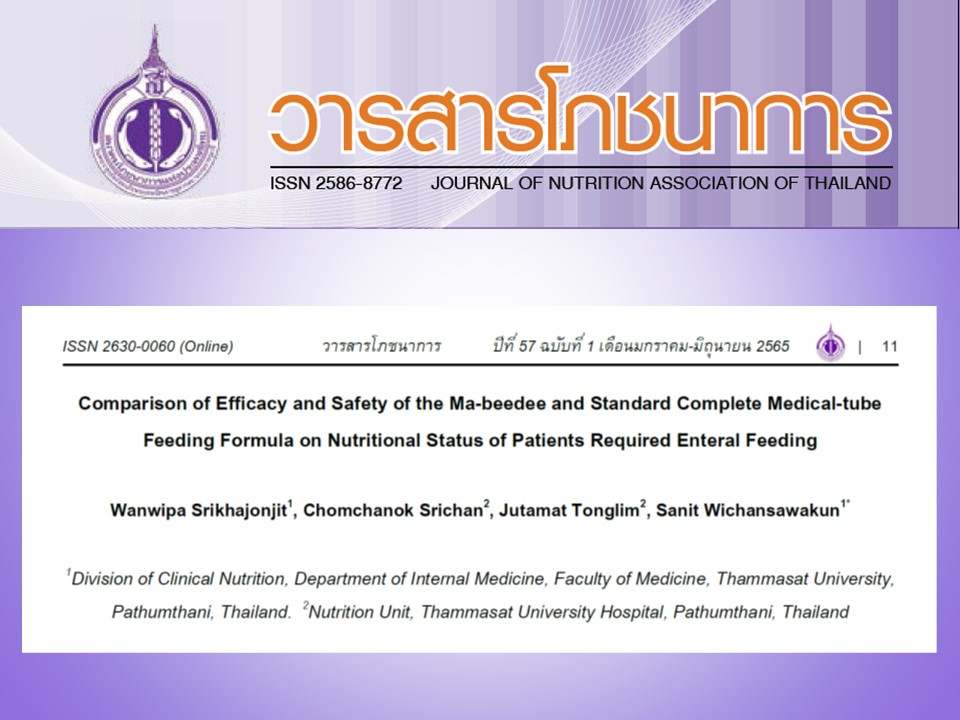Comparison of Efficacy and Safety of the Ma-beedee and Standard Complete Medical-tube Feeding Formula on Nutritional Status of Patients Required Enteral Feeding
Keywords:
Malnutrition, Enteral nutrition, Medical foodAbstract
Malnutrition contributes to increased morbidity and mortality. Appropriate nutritional therapy can prevent malnutrition. Enteral feeding is a standard nutritional intervention given to patients who cannot get adequate nutritional requirements by volitional intake. This study aims to compare the efficacy and safety of a new standard formula, Ma-beedee, to the standard polymeric formula on the nutritional status of patients receiving enteral feeding. The study was a blind-randomized controlled trial in adult patients treated with enteral feeding. Thirty-eight patients were fed with the standard polymeric formula, while thirty-nine were fed with Ma-beedee for 14 days. The outcomes are to compare changes of body weight, pre-albumin, and other laboratory results and determine the side effects of enteral feeding. There were no significant differences in baseline characteristics of both study and control groups. Also, there were no significant differences in nutritional parameter and number of side effect from enteral feeding between 2 groups after 14 days of enteral nutrition. However, after 14 days of enteral feeding, in the Ma-beedee group, there was a statistically significant increase in pre-albumin and albumin from 17.93±6.88 to 22.50±7.26 mg/dL (p<0.0001), and 2.96±0.50 to 3.18±0.53 g/dL (p=0.0012), respectively. In the standard formula, there was a statistically significant increase in body weight from 45.46±9.0 to 46.30±9.34 kg (p=0.025). However, there was no statistically significant increase in pre-albumin. Ma-beedee has an efficacy and safety outcomes to use as enteral feeding as the standard polymeric formula.
References
Norman K, Pichard C, Lochs H, Pirlich M. Prognostic impact of disease-related malnutrition. Clin Nutr 2008; 27(1):5-15.
Chima CS, Barco K, Dewitt MLA, Maeda M, Teran JC, and Mullen KD. Relationship of nutritional status to length of stay, hospital costs, and discharge status of patients hospitalized in the medicine service. J Am Diet Assoc 1997; 97:975-8.
Correia MI, Waitzberg DL. The impact of malnutrition on morbidity, mortality, length of hospital stay and costs evaluated through a multivariate model analysis. Clin Nutr 2003; 22(3):235-9.
Yeh DD, Fuentes E, Quraishi SA, Cropano C, Kaafarani H, Lee J, et al. Adequate Nutrition May Get You Home: Effect of caloric/protein deficits on the discharge destination of critically ill surgical patients. JPEN J Parenter Enteral Nutr 2016; 40(1):37-44.
Debaveye Y, Berghe G.VD. Risk and benefit of nutrition support during critical illness. Annu Rev Nutr 2006; 26:513-38.
ดรุณีวัลย์ วโรดมวิจิต, ปรียานุช แย้มวงศ์, ประณิธิ หงประภาส, กวีศักดิ์ จิตตวัฒนรัตน์, จงจิตร อัคทะวานิช, วรีเดช พิศประเสริฐ และ คณะ. คำแนะนำการดูแลทางโภชนาการในผู้ป่วยผู้ใหญ่ที่นอนโรงพยาบาล พ.ศ. 2560. วารสารโภชนบำบัดปีที่ 27 ฉบับที่ 1 2562.
Wichansawakun S, Meddings L, Alberda C, Robbins S, Gramlich L. Energy requirements and the use of predictive equations versus indirect calorimetry in critically ill patients. Appl Physiol Nutr Metab 2015; 40(2):207-10.
Friedli N, Stanga Z, Culkin A, Crook M, Laviano A, Sobotka L, et al. Management and prevention of refeeding syndrome in medical inpatients: an evidence-based and consensus- supported algorithm. Nutrition 2018;47:13-20.
Trakulhoon V, Prammanasudh B. An open study of efficacy, safety and body weight changing in the blendera-tube fed patients. J Med Assoc Thai 2012; 95(10):1285-91.
Sripongpun P, Lertpipopmetha K, Chamroonkul N, Kongkamol C. Diarrhea in tube-fed hospitalized patients: Feeding formula is not the most common cause. J Gastroenterol Hepatol 2021; 36(9):2441-2447.
Jayanama K, Maitreejorn P, Tangsermwong T, Phanachat P, Chattranukulchai P, Tanlakit P, et al. The amelioration of nutritional status and phase angle, safety, and satisfaction in tube-fed patients with ready-to-use blenderized diet with chicken and pumpkin. Rama Med J 2019; 42(4):12-19.

Additional Files
Published
Versions
- 2022-06-02 (2)
- 2022-06-02 (1)
How to Cite
Issue
Section
License
Upon acceptance of an article, copyright is belonging to the Nutrition Association of Thailand.


